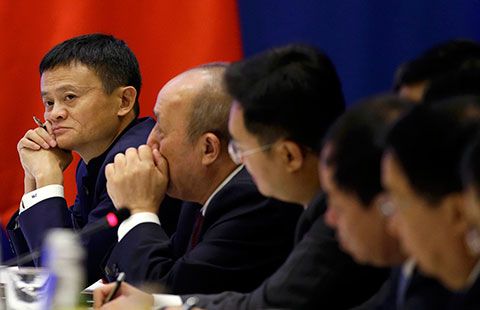Ethnic equality, unity and development in Xinjiang
Updated: 2015-09-25 06:33
(China Daily)
|
||||||||
IX. State Support and Assistance to Xinjiang
The CPC and the Chinese government have always attached great importance to the development of Xinjiang, and have continuously increased their support and assistance. Over the past 60 years, the state's financial grants to Xinjiang totaled almost RMB1.7 trillion. The state and other provinces, autonomous regions and municipalities directly under the central government have at different times provided support to Xinjiang in various forms, acting as a strong driving force to boost the region's economic and social development.
State support has laid the foundation for Xinjiang's development. From the founding of the autonomous region to the launch of the reform and opening-up drive, the state had, by way of job allocation and job transfer, encouraged intellectuals and technical professionals to go to work in Xinjiang, called on young adults, urban educated youth and workers in inland areas of the country to support frontier development and encouraged demobilized service people to stay in Xinjiang and assigned them jobs there, thus fostering a generation of builders who have been hard-working and pioneering and took roots in the border areas. They have made an invaluable contribution to Xinjiang's economic and social development, to the cultivation and defense of the border regions as well as national security.
The state has supported Xinjiang to boost its development by adopting quite a number of measures, such as checking and ratifying on a yearly basis its balance of total revenues and expenditures, and turning in to the state the surplus while having the deficiency to be made up by the central budget; raising the proportion of budget reserves for ethnic minority areas; implementing preferential policies for ethnic trade companies; and establishing various special funds like special allowance funds of education for ethnic minority areas, and ethnic minority area allowances. From 1955 to 1978, the state subsidized Xinjiang with RMB7.19 billion accumulatively. With hefty state funds, many major infrastructure and other industrial projects in the region have been completed, including the Lanzhou-Urumqi Railway and the Karamay and Tarim oilfields.
The state has strengthened both policy and financial support to Xinjiang. Since the adoption of the reform and opening-up policy, the state has kept intensifying efforts to support Xinjiang in such fields as economy, education, science and technology, culture, medical services, ecological and environmental protection, and finance. From 1980 to 1988, the central budget provided a quota subsidy to Xinjiang with an average yearly increase of 10 percent. In 1994, when the state introduced tax revenue-sharing between the central and local authorities, it maintained the previous policies of providing subsidies and special allocations to ethnic minority areas. When it adopted transitional transfer payments the following year, it added special provision concerning the policy of transfer payments to ethnic minority areas.
The state has guided and encouraged businesses to invest in Xinjiang, and provided greater investment and financial support to Xinjiang. In 2005, it initiated pairing-assistance to the four prefectures and the three divisions under the XPCC in southern Xinjiang. In 2007, it promulgated the Opinions of the State Council on Further Boosting Xinjiang's Economic and Social Development.
The state has also trained and provided talents for Xinjiang. In the 1980s, it initiated a cooperative program between Xinjiang and more than 100 institutions of higher learning in other parts of the country, with the total enrollment eventually growing from 800 to 6,800. By 2014, these institutions had enrolled, accumulatively, 54,000 students of ethnic minority origins from Xinjiang, in addition to providing the autonomous region with 21,000 undergraduates and junior college graduates. In 2000, the state launched a program encouraging senior high schools in hinterland areas of the country to hold classes of students from Xinjiang, so far enrolling in total 70,000 from Xinjiang, 38,000 of whom have graduated, with 95 percent continuing their studies in colleges located in the developed provinces, municipalities and autonomous regions. Since 2003, junior high school classes have been set up in some cities of Xinjiang, enrolling to date a total of 61,300 students from remote impoverished aseas. Senior high school classes and secondary vocational classes were opened in 2011 in other parts of the country for Xinjiang students, which have thus far enrolled 13,200 students.
All of these senior-high-school and junior-high-school classes held in hinterland areas target mainly ethnic minority students from Xinjiang's farming and pasturing areas to offer them a better education. At present, more than 100,000 ethnic minority students are studying in nearly 600 schools in some 20 economically better developed provinces, municipalities directly under the central government and autonomous regions.
In 1996, the state began to extend support to Xinjiang's development by way of selecting and sending officials to work in Xinjiang. By 2014, it had sent eight complements numbering more than 11,000 officials and professionals. In 2004, a new initiative involved sending qualified professionals with doctor's degrees to work in the region. By 2014, 11 groups of 81 persons with doctor's degrees had gone and worked in the autonomous region through this project.
The state has also implemented a number of other talent training policies, such as selecting and appointing officials of ethnic minority origins to temporary posts in central government offices or in areas with better developed economy to get training; holding Xinjiang classes in inland higher-learning institutions and senior high schools; implementing such programs as the "Program for High-Caliber Personnel from Ethnic Minorities" and "Light of the West" for the training of visiting scholars; and giving special policy support to the development of higher-learning institutions located in the ethnic minority areas or the master's and doctor's degree granting centers of ethnic colleges and universities in terms of graduate enrollment size, etc.
The new round of pairing-assistance has yielded notable results. The First National Meeting on Pairing-Assistance to Xinjiang was held in March 2010. At the meeting, the central authorities decided to pair off 19 provinces and municipalities directly under the central government with 82 counties (cities) in 12 prefectures in Xinjiang and the 12 divisions of the XPCC to render support to the latter.
- Another corruption suspect repatriated from US to China
- Shanghai slaps three-year ban on entertainers caught doing drugs
- 37 students critical after botched fire drill in NW China
- Man writes Chinese calligraphy using kitchenware
- Brilliant Autumn Urumqi feasting many eyes
- Kids serve as traffic police in C China
- Colombia, FARC reach breakthrough agreement in Havana
- White House prepares for government shutdown
- EU leaders seek unity on refugee plans
- EU pushes through plan to relocate 120,000 refugees amid oppositions
- China, Malaysia conclude first joint military exercise
- Hillary Clinton opposes controversial oil pipeline

 Here's what's on the menu for the state dinner
Here's what's on the menu for the state dinner
 President Xi visits Microsoft campus in Seattle
President Xi visits Microsoft campus in Seattle-
 Xi revisits Lincoln High School after 1993 bond
Xi revisits Lincoln High School after 1993 bond 
 Chinese, US business leaders gather at roundtable meeting
Chinese, US business leaders gather at roundtable meeting-
 Xi visits assembly line of plane manufacturer Boeing in US
Xi visits assembly line of plane manufacturer Boeing in US -
 First Lady tours Fred Hutchson Cancer Research Center
First Lady tours Fred Hutchson Cancer Research Center 
 Boeing to sell 300 planes to China
Boeing to sell 300 planes to China-
 Sino-US ties need more understanding: Xi
Sino-US ties need more understanding: Xi
Most Viewed
Editor's Picks

|

|

|

|

|

|
Today's Top News
Young people from US look forward to Xi's state visit: Survey
US to accept more refugees than planned
Li calls on State-owned firms to tap more global markets
Apple's iOS App Store suffers first major attack
Japan enacts new security laws to overturn postwar pacifism
Court catalogs schools' violent crimes
'Beauty of Beijing's alleys akin to a wise, old person'
China makes progress fighting domestic, international cyber crime
US Weekly

|

|







